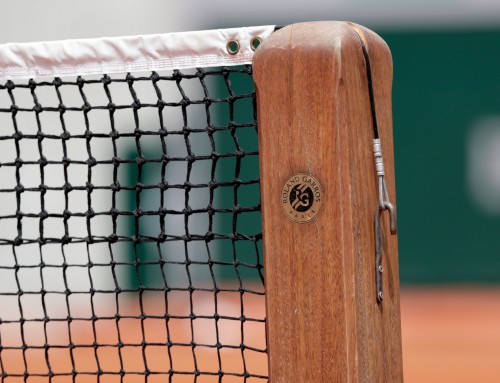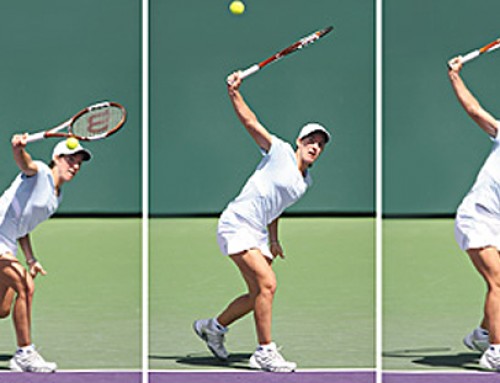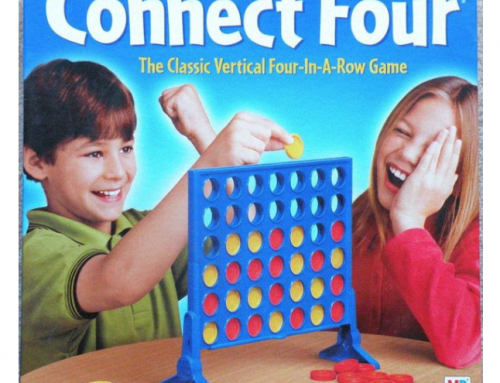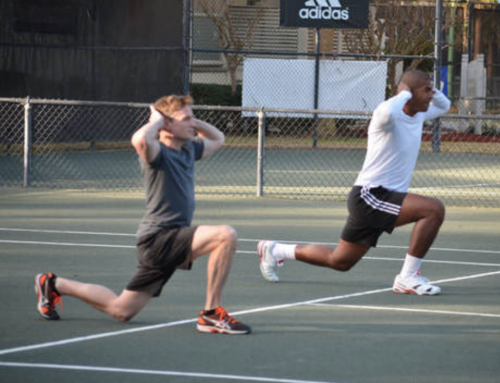Do you get nervous when you play tennis matches?
Do you get tight, lock up, and become a totally different player once score is being kept?
If so the post from the other day and today post are going to be incredibly helpful.
I laid the groundwork by revealing what causes those nervous symptoms, why it’s there, and what your response to it should be (hint – it requires dancing).
Don’t read today’s message without learning those things first: https://www.facebook.com/essentialtennis/posts/10157363496109561?__tn__=K-R
If you already read it, here’s a lightning fast recap to bring your brain back up to speed:
The thing we’re dealing with is FEAR.
You’re SUPPOSED to be afraid!
You have to dance with the fear.
It’s that third part we’re going to focus on today because it’s so opposite of what most tennis players have been taught…
Over the years you’ve probably been told to try many of these things to combat nerves and tightness:
Looking at your strings between points.
Telling yourself that you’re behind when you’re really ahead.
Positive affirmations and other uplifting self talk.
Reminding yourself that it’s just a game.
Unfortunately those are just tricks and gimmicks.
They only address the surface SYMPTOMS instead of getting to the root of the issue: the fear.
Thankfully now you know that the fear is totally normal, natural, and as long as you love tennis and have a passion for improvement it will always be there.
Instead of frantically trying to push it away, ignore it, or trick yourself into thinking its not there (which only makes it worse) you should be making friends with it.
The more comfortable you get with being uncomfortable the better you’ll perform when it really matters most. That’s why we LOVE watching elite, world class tennis players! They feel all the same things we feel (and much more, remember Stan’s story from yesterday?) but still find a way to execute incredible shots and come out on top.
Now it’s time for you to learn how to do the same thing 🙂
==========================
Step 1: Learning Zone Principle
==========================
The first part of learning how to dance with the fear is understanding how to find just the right training environment.
There are three levels of challenge that you could potentially put yourself in, but only one will be helpful:
Comfort Zone – What you’ve already mastered, what’s already familiar, it won’t make you uncomfortable at all.
Learning Zone – Outside your comfort zone, just stretching to the edges of what you’ve capable of but without overwhelming yourself.
Panic Zone – Outside your learning zone, completely uncomfortable and distressing, no longer helpful for training.
Unfortunately most players jump back and forth, back and forth between their Comfort Zone and their Panic Zone.
They’ll go out and hit with familiar friends, go to team practice or a drill, all of which are designed to get them to feel as confident and solid as possible, building their ego.
Then, after days of worry and build up, they jump right into a critical team match with all their peers watching, the weight of the world on their shoulders.
Sound familiar?
That extreme swing from comfort to panic will continually reinforce that FEAR IS BAD and the goal becomes trying to get matches to feel like practice….
Guess what?
They never, ever will. They’re completely different!
And so, the goal shouldn’t be to take away the fear, but to get more and more familiar, accepting, and even comfortable with it.
Here’s how:
======================
Step 2: Learning To Dance
======================
They objective is purposefully setting up points with a surrounding environment that you KNOW will take you out of your comfort zone, but won’t trigger you all the way into your panic zone.
Here’s one simple example, but the possibilities are literally endless:
Rally cross court groundstrokes with a partner on the deuce side of the court so you’re both hitting forehands (if you’re both right handed).
In the middle of the deuce side of no-mans land on each side lay down a large beach towel to act as a target area. Towels make great targets because they jump up when a ball lands on top of them.
Now rally cross court, working on your depth and accuracy while keeping track of score, one point for each successful towel hit.
(You can do this with serves, volleys, overheads, or any other shot in the game, this is just one example!)
First player to 10 target hits wins the game.
Here’s the key – Decide ahead of time what the loser is going to have to do. Here’s some ideas:
Play for points only – no additional penalty
Play for pushups
Play for $20
Play for beers
Play for dinner
Play for a selfie video posted to Facebook saying the other player is AMAZING
Here’s the thing: different people are going to respond very, very differently to each of those penalties.
One player might not feel any tension or nerves at all about having to do pushups, while another might get put right into their “Panic Zone”.
Without purposefully leaving your comfort zone, competing in a controlled environment, and putting things on the line you’ll never find out, and you’ll never develop the ability to perform under pressure.
This is how you learn to dance with the fear.
================
Step 3: Take Action
================
So what are you going to do?
Are you going to continue pushing the fear away, thinking there’s something wrong with you every time it shows up, and trying to trick yourself into not feeling it?
Or, are you going to take action, purposefully leave your comfort zone, and take control of your competitive development?
Shoot me a quick comment and let me know what you’re thinking, and how you plan to move forward.
I’d love to hear from you 🙂
Thanks for reading and have an amazing weekend.
Yours Truly,
-Ian







